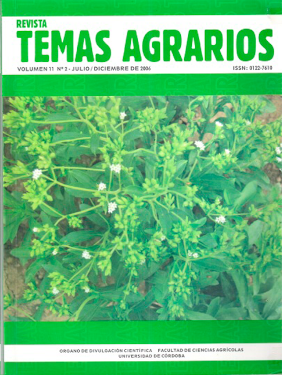Development of an in vitro propagation protocol for roble (Tabebuia rosea Bertol DC)
Desarrollo de un protocolo para propagación in vitro de roble (Tabebuia rosea Bertol DC)

This work is licensed under a Creative Commons Attribution-NonCommercial 4.0 International License.
Show authors biography
A significant advance for oak (Tabebuia rosea) micropropagation has been developed in order to massively propagate clones. The effect of three sodium hypochlorite concentration (1%, 2% and 3%) at three times (5, 10 y 15 min) on surface disinfestations were evaluated using explants consisting of 2-3 cm axillary shoots established on ½MS with (in mg L-1) mio inositol (100), sucrose (30,000), thiamine HCl (0.4) and TC agar (8,000) (Sigma Co.). Five BAP (0.00, 2.22, 4.44, 8.88, 17.76 µM) concentration were evaluated for shoot multiplication and ANA at 0.00, 1.35, 2.69, 4.03 y 5.37 µM were evaluated for shoot rooting, both experiments had 15 replicates for treatment distributed in a complete randomized design. In vitro multiplied and rooted shoots were transferred to ex vitro for acclimatization. Ten percent sodium hypochlorite at 10 minutes was the best surface disinfecting treatment. BAP at 17.76 µM induced the higher multiplication rate while rooting was better with 5.37 µM ANA. Only in vitro rooted shoots survived to ex vitro conditions at a low rate indicating the need for further investigation to improve ex vitro acclimatization.
Article visits 3058 | PDF visits
Downloads
- Ahuja, M. 1992. Micropropagation of woody plants. Kluwer Academic Publishers, The Netherlands, 536p.
- Abdelnour, E. y Muñoz, A. 1997. Micropropagación de especies forestales. X Congreso Forestal Nacional de Especies Forestales, San José de Costa Rica
- Amutha, S.; Muruganantham, M. y Ganapathi, A. 2006. Thidiazuroninduced high-frequency axillary and adventitious shoot regeneration in Vigna radiata (l.) wilczek. In Vitro Cellular and Dvelopmental Biology – Plant 42(1):26-30
- Avila, M. 2004. Eficiencia del hipoclorito de sodio como desinfectante superficial en segmentos nodales de roble (Tabebuia rosea), cedro (Cedrela odorata) y abarco (Cariniana pyriformis) a nivel in vitro. Tesis Ingeniero Agrónomo, Universidad de Córdoba, Montería
- Biroscikova, M.; Spisakova, K.; Liptak, S.; Pichler, V. y Durkovic, J. 2004. Micropropagation of mature wych elm (Ulmus glabra Huds). Plant Cell reports 22(9):640-644
- Bunn, E.; Senaratna, T.; Sivasithamparam, K. y Dixon, K. 2005. In vitro propagation of Eucalyptus phylacis L. Johnson and K. Hill, a critically endangered relict from Western Australia. In Vitro Cellular and Developmental Biology – Plant 41(6):812-815
- Carrizosa, M.; Ramírez, C.; Guerrero, E.; Santamaría, L. y Hodson, E. 1994. Cultivo de tejidos para la propagación y mejoramiento de especies forestales. Memorias III Congreso de Especies Forestales, Bogotá, Universidad Javeriana, p547-559
- Castro, D.; Díaz, G. y Linero, J. 2002. Propagación clonal in vitro de árboles élites de teca (Tectona grandis L.). Revista Colombiana de Biotecnología 4(1):49-53
- Castro, D.; Díaz, J. y Murillo, M. 1999. Estrategias de trabajo para la multiplicación clonal in vitro de árboles adultos de Teca (Tectona grandis), Melina (Gmelina arborea) y Roble (Tabebuia rosea). Universidad Católica de Oriente, Rionegro, p16- 51
- Chalupa, V. 2002. In vitro propagation of mature trees of Sorbus aucuparia L. and field performance of micropropagated trees. Journal of Forest Science 48:529-535
- Colorado, A. 2003. Roble. Especie que reune la fuerza y belleza del bosque. Revista M & M - El Mueble y la Madera 41:13-19
- CONABIO (Comisión Nacional Para el Uso y Conocimiento de la Biodiversidad). 2005. Tabebuia rosea. http:// www.conabio.gob.mx/ conocimiento/info_ especies/arboles/ doctos/11-bigno7m.pdf#search=%22 Tabebuia%20rosea%22. México, D.F. [Accedido: 08-25-2006]
- Daquinta, M.; Ramos, L.; Capote, I.; Lezcano, Y.; Rodríguez, R.; Trina, D. y Escalona, M. 2001. Micropropagación de la teca (Tectona grandis L.F.). Revista Forestal Centroamericana 35:23-28
- DNP (Departamento Nacional de Planeación). 2003. Documento CONPES 3237. Política de Estímulo a la Reforestación Comercial en Colombia: 2003-2006.
- Departamento Nacional de Planeación, Bogotá, 20p. Gamboa, J. y Aldenour, A. 1999. Micropropagación de Melina (Gmelina arborea ROBX). Agronomía Costarricense 23:69-76
- Iriondo, J.; De La Iglesia, M. y Pérez, C. 1995. Micropropagation of Eleagnus angustifolia from mature tress. Tree Physiology 15(10):691-693
- Kane, M. 1996. Micropropagation from preexisting meristemos, En: Gray D y Trigiano R (Ed.) Plant Tissue Culture Concepts and Laboratory Exercises. CRC Press, Boca Ratón, p75-86
- Lara, A.; Valverde, R.; Gómez, L. y Hidalgo A. 2003. Micropropagación de la planta medicinal Psycotria acuminata L. Agronomia Costaricense 27:7-20
- Leifert, C. y Cassells, A. 2001. Microbial hazards in plant tissues and cell culture. In Vitro Cell and Developmental Biology-Plant 367:133-138
- Murillo, O. 2004. Calidad y valoración de plantaciones forestales. Instituto Tecnológico de Costa Rica, Cartago, p7-9
- Nadgauda, R. 1999. Application of tissue culture in clonal forestry programme. Proceedings International Tree Biotechnology Meeting, India, p4-8
- Ndoye, M.; Diallo, I. y Gassama/Dia, Y. 2003. In vitro multiplication of the semiarid forest tree Balanities aegyptiaca L. African Journal of Biotechnology 2(11):421-424
- Pruski, K.; Astatkie, T. y Nowak J. 2005. Tissue culture propagation of Mongolian cherry (Prunus fruticosa) and Nankin cherry (Prunus tormentosa). Plant Cell, Tissue and Organ Culture 82(2):207-211
- Ramírez, O. y Gómez, M. 1999. Estimación y valoración económica del almacenamiento de carbono. Revista Forestal Centroamericana 27:8-12
- Schoene, G. y Yeager, T. 2005. Micropropagation of sweet viburnum (Viburnum odoratissimum). Plant Cell, Tissue and Organ Culture 83(3):271-277
- Suárez, I.; Schnell, R.; Kuhn, D. y Litz, R. 2005. Micrografting of ASBVdinfected avocado (Persea americana) plants. Plant Cell, Tissue and Organ Culture 80:179-185
- Sudha, C.; Krishnan, P.; Pushpangadan, P. y Seeni, S. 2005. In vitro propagation of Decalepis arayalpathra, a critically endangered ethnomedicinal plant. In Vitro Cellular and Developmental Biology – Plant 41(5):648-654
- Tiwari, S.; Tiwari, K. y Siril, E. 2002. An improved micropropagation protocol for teak. Plant Cell, Tissue and organ Culture 71:1-6
- USDA-GRIN. 2006. ARS, National Genetic Resources Program, Germplasm Resources Information Network. National Germplasm Resources Laboratory, Beltsville, http:// www.ars-grin.gov/cgi-bin/npgs/html/ taxon.pl?105257. [Accedido:10-04- 2006]
- Viloria, Z. 1993. Cultivo in vitro de nudos de guayaba (Psidium guajaba L.). Universidad del Zulia, Maracaibo, 35p




















